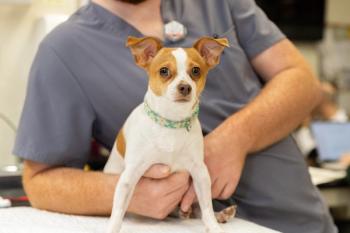
Update on feline infectious peritonitis (Proceedings)
Feline infectious peritonitis (FIP) continues to be a significant disease in domestic cats.
Feline infectious peritonitis (FIP) continues to be a significant disease in domestic cats. The pathogenesis of FIP is complex, involving feline coronavirus (FCoV) and an inappropriate humoral response to the virus. Only a minority of FCoV-infected cats develop the lethal disease, and genetic factors are known to play a role in disease development.
Virus factors are important to disease development, as virus strains vary in virulence. It has been theorized that a viral mutation is responsible for the change in biotype of the virus leading to disease production. Speculation on the genomic locale of this mutation has involved the gene encoding the spike protein, as well as genes encoding several nonstructural proteins including 3c, 7a, and 7b. However, no consistent genetic difference between virulent and avirulent biotypes has been found. In fact, a recent study found 100% homology between the enteric and non-enteric viral genome from a cat with FIP. There do appear to be quantitative differences in viral RNA levels in the blood of cats with and without FIP. Rising amounts of viral RNA in the blood seen in end-stage disease may indicate that loss of immune control leads to enhanced viral replication and disease progression. This increased viral replicative capacity may be a key element of FIP pathogenesis.
The lesions associated with FIP are due primarily to immune-mediated destruction. Type II and III hypersensitivity reactions are involved, with immune complex formation, activation of complement, and cytotoxicity of infected macrophages releasing inflammatory mediators. Neutrophils also are attracted to the lesions and release inflammatory mediators as well as cytotoxic factors. Resultant lesions are associated with the vasculature, especially at serosal surfaces, with increased vascular permeability and pyogranulomatous changes.
In addition to immune-mediated tissue destruction, lymphocyte depletion, particularly of T lymphocytes, is observed in affected cats. Despite lack of viral infection of these cells, this lymphocyte depletion is characteristic of the disease, and has been found to correlate with enhanced viral replication. Activated, but not resting lymphocytes appear to be killed by soluble mediators; thus, FIPV-specific lymphocytes activated by infection are effectively singled out for destruction. Apoptotic factors released from phagocytes may be responsible for this depletion. Cell-mediated immunity with cytotoxic T lymphocytes is critical for protection against FIP; accordingly, this T lymphocyte depletion associated with FIP leads to reduced viral clearance.
Susceptibility to disease following FCoV infection appears to be inherited, with breed and familial predisposition. The host genetic factors that lead to increased susceptibility are not clear, but seem to involve the immune response to FCoV infection, in particular, a shift from T helper lymphocyte type I (Th1) to Th type 2 (Th2) response to the infection. The former are important in coordinating cell-mediated immunity, which is protective against FIP, while the latter are important in humoral response. This shift results in an exaggerated humoral response which is not protective, and in fact actually enhances the disease progression as it enhances monocyte/macrophage virus infection and mediates the immunopathology. Since lymphocytes are not target cells of FCoV, it is theorized that secreted factors, including cytokines are critical to the lymphocyte effects, such as the Th2 response and T lymphocyte depletion. In fact, the T lymphocyte response appears to be the decisive factor in disease progression.
Cytokines are important mediators of the immune response. Monocytes and macrophages are major cytokine producers, and are also the target of FIPV infection. T helper lymphocytes are the other major cytokine producer, and determine in large part whether the cell-mediated (via Th1) or humoral (via Th2) arm of the immune response dominates. The cytokine secretion patterns from these cells thus determine the magnitude and direction of the immune response. Cytokines associated with cell-mediated immunity, such as IL-10 and -12, and IFN -γ have been found to decrease in cats that develop FIP. Elevations in cytokines IL-1β and IL-6 have also been found in affected cats which may contribute to the humoral response. An increase in TNF-α has been observed in some studies, and may contribute to the T lymphocyte apoptosis.
Clinical signs of FIP, particularly the dry form, are often vague; in addition, changes in clinical parameters are not pathognomonic for FIP. Feline coronavirus infection is common, thus evidence of infection is not diagnostic for FIP. Though diagnosis of FIP is critical, ante mortem diagnosis of FIP can be a challenge, requiring a combination of diagnostic criteria. Recently, tests for FCoV with claims to specificity for FIP have become available. An FIP-specific ELISA is available from one commercial laboratory that detects antibody to a specific viral protein, the 7b protein. This protein has been speculated to be a virulence factor of FCoV. In one study, investigators theorized that 7b expression may be suppressed in many infections, and removal of this suppression and 7b expression by a mutational event may lead to increased virulence of the virus. If expression of the 7b protein did consistently lead to disease production, cats infected with virulent FIP-inducing FCoV would be expected to have measurable antibody to this virus protein, while cats infected with the nonvirulent FCoV would not. However, another study found that while cats suffering from FIP did have antibody to this protein, many cats, both healthy and with other disease conditions were also 7b seropositive. Thus it is not specific for a diagnosis of FIP.
Another assay uses detection and quantitation of FCoV mRNA in blood to assist diagnosis. While viral RNA can be found in the blood of healthy FCoV-infected cats without FIP, higher levels of viral RNA have been found in cats with end-stage FIP. Detection of high levels of mRNA, as opposed to genomic RNA, indicates efficient viral replication in blood cells, a characteristic of the virus of FIP. This is the basis for the PCR assay offered at one commercial laboratory; however, claims to specificity for FIP are not made, and results are to be interpreted in light of other clinical data. It is not known how the cutoff level of mRNA referred to in this assay was determined, nor is it known what level of viral mRNA may occur in cats without FIP. In general, results of any "FIP test" must be interpreted with caution.
Treatment of FIP has largely been unsuccessful. Some animals with minimal involvement, such as anterior uveitis only, may respond to anti-inflammatory medications. Glucocorticoids as well as other immunosuppressive drugs may slow the disease progression, but do not cure FIP. Various antiviral drugs have also been tried with minimal success. Immuno-modulating drugs have been used in an attempt to reduce viral burden by enhancing the immune response. While interferon, both human and feline, has shown efficacy in vitro, no reduction in mortality was seen when used in vivo either prophylactically or therapeutically.
References
Addie, D. D., L. J. Kennedy, R. Ryvar, K. Willoughby, R. M. Gaskell, W. E. R. Ollier, P. Nart, and A. D. Radford. 2004. Feline leucocyte antigen class II polymorphism and susceptibility to feline infectious peritonitis. Journal of Feline Medicine and Surgery 6:59-62.
Can-Sahna, Kezban, Veysel Soydal Ataseven, Dilek Pinar, Tuba C. Oguzoglu. 2007. The detection of feline coronaviruses in blood samples from cats by mRNA RT-PCR. Journal of Feline Medicine and Surgery:1-4.
Dye, C., and S. G. Siddell. 2007. Genomic RNA sequence of feline coronavirus strain FCoVC1Je. Journal of Feline Medicine and Surgery 9:202-213.
Foley JE, Pedersen NC. 1995. The inheritance of susceptibility to feline infectious peritonitis in purebred catteries. Feline Practice 24, 14-22.
Gelain, M. E., M. Meli, and S. Paltrinieri. 2006. Whole blood cytokine profiles in cats infected by feline coronavirus and healthy non-FCoV infected specific pathogen-free cats. Journal of Feline Medicine and Surgery 8:389-399.
Goitsuka, R., T. Ohashi, K. Ono, K. Yasukawa, Y. Koishibara, H. Fukui, Y. Ohsugi, and A. Hasegawa. 1990. IL-6 ACTIVITY IN FELINE INFECTIOUS PERITONITIS. Journal of Immunology 144:2599-2603.
Gunn-Moore, D. A., S. M. A. Caney, T. J. Gruffydd-Jones, C. R. Helps, and D. A. Harbour. 1998. Antibody and cytokine responses in kittens during the development of feline infectious peritonitis (FIP). Veterinary Immunology and Immunopathology 65:221-242.
Gut, M., C. M. Leutenegger, J. B. Huder, N. C. Pedersen, and H. Lutz. 1999. One-tube fluorogenic reverse transcription-polymerase chain reaction for the quantitation of feline coronaviruses. Journal of Virological Methods 77:37-46.
Herrewegh, A. A., I. Smeenk, M. C. Horzinek, P. J. Rottier, and R. J. d. Groot. 1998. Feline coronavirus type II strains 79-1683 and 79-1146 originate from a double recombination between feline coronavirus type I and canine coronavirus. Journal of Virology 75:4508-14.
Herrewegh, A. A., H. Vennema, M. C. Horzinek, P. J. Rottier, and R. J. de Groot. 1995. The Molecular Genetics of Feline Coronaviruses: Comparative Sequence Analysis of the ORF7a/7b Transcription Unit of Different Biotypes. Virology 212:622-631.
Kennedy, DVM, Melissa, Mohamed Abd-Eldaim; Sarah E. Zika, Joseph M. Mankin, and Stephen A. Kania. 2008. Detection of antibodies in cats specific for the 7b protein of feline coronavirus and its value for diagnosis of feline infectious peritonitis (FIP). AJVR, in press.
Kipar, A., H. May, S. Menger, M. Wrbrt, W. Leukert, and M. Reinacher. 2005. Morphologic Features and Development of Granulomatous Vasculitis in Feline Infectious Peritonitis. Veterinary Pathology 42:321-330.
Meli, M., A. Kipar, C. Muller, K. Jenal, E. Gonczi, N. Borel, D. Gunn-Moore, S. Chalmers, F. Lin, M. Reinacher, and H. Lutz. 2004. High viral loads despite absence of clinical and pathological findings in cats experimentally infected with feline coronavirus (FCoV) type I and in naturally FCoV-infected cats. Journal of Feline Medicine and Surgery 6:69-81.
Pesteanu-Somogyi, Loretta D., Christina Radzai, Barrak M Pressler. 2006. Prevalence of feline infectious peritonitis in specific cat breeds. Journal of Feline Medicine and Surgery 8:1-5.
Rohrbach BW, Legendre AM, Baldwin CA, Lein DH, Reed WM, Wilson RB. 2001. Epidemiology of feline infectious peritonitis among cats examined at veterinary medical teaching hospitals. Journal of the American Veterinary Medical Association 218, 1111-1115.
Simons, Fermin A., Harry Vennemac, Jaime E. Rofina, Jan M. Pol, Marian C. Horzinek, Peter J.M. Rottier, Herman F. Egberink. 2005. A mRNA PCR for the diagnosis of feline infectious peritonitis. Journal of Virological Methods 124: 111–116.
Takano, T., T. Hohdatsu, Y. Hashida, Y. Kaneko, M. Tanabe, and H. Koyama. 2007. A "possible" involvement of TNF-alpha in apoptosis induction in peripheral blood lymphocytes of cats with feline infectious peritonitis. Veterinary Microbiology 119:121-131.
Vennema H, Poland A, Foley J, et al. Feline infectious peritonitis viruses arise by mutation from endemic feline enteric coronaviruses. Virology 1998;243:150-157.
Vennema, H., J. W. A. Rossen, J. Wesseling, M. C. Horzinek, and P. J. M. Rottier. 1992. GENOMIC ORGANIZATION AND EXPRESSION OF THE 3' END OF THE CANINE AND FELINE ENTERIC CORONAVIRUSES. Virology 191:134-140.
Newsletter
From exam room tips to practice management insights, get trusted veterinary news delivered straight to your inbox—subscribe to dvm360.





